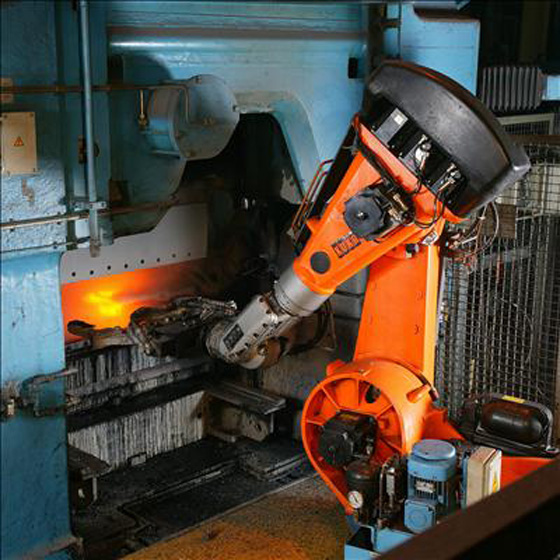Kelley seeks to apply ultrasound to improve metal casting process
August 3, 2016

Robotics is one example of next-generation metal casting; Douglas Kelley, assistant professor of mechanical engineering, will explore whether ultrasound can be another way to improve the process. (Photo from KUKA Roboter GmbH, Wikemedia Commons)
If ultrasound could take images of molten metal inside a mold -- as effectively as it does with a human embryo -- the efficiency of metal casting could be greatly improved, benefiting an industry dominated by small companies and narrow profit margins, says University of Rochester researcher Douglas Kelley.
But there is a daunting challenge that he and his collaborator at MIT must first overcome: finding a way for ultrasound signals to penetrate churning flows of metal, heated to 2,000-3,000 degrees Fahrenheit, and return useful images of what happens as the metal solidifies inside the mold.
This has been “notoriously tricky” to do up to now, Kelley says, often resulting in unexplained echoes and unreliable signals.
Kelley, an assistant professor of mechanical engineering, has received a $273,000 grant from the National Science Foundation to collaborate on possible solutions with Antoine Allanore, assistant professor of metallurgy at MIT.
There are good reasons to look for next-generation metal casting techniques, Kelley notes. More than 90 percent of U.S. manufactured goods contain cast metal components. Use of ultrasound to monitor conditions inside those casting vessels – as the casting occurs – could provide richly detailed images of the flow patterns of the liquid metal and its solidification patterns.
That, in turn, could help engineers design more uniform cooling processes, and detect cracks, voids, and impurities before final ingots are produced. Casting companies could achieve “reliability, reproducibility, and productivity never before possible, all at lower cost,” Kelley and Allanore noted in their proposal.
Kelley says that the biggest obstacles to obtaining ultrasound images from inside a mold occur at the interfaces between:
• Different layers of solid and liquid that form as the metal begins to solidify.
• The metal and the inner surface of the mold.
• The ultrasound probe and whatever is touching it.
“Liquid metals have high surface tension, so they often pull away from whatever is next to them,” Kelley says. This can cause thin gas layers to form, for example, between the metal and the mold that encloses it. Those gas layers can distort or completely block ultrasound signals.
The researchers will explore several approaches that might enable the liquid metal to uniformly adhere to a mold’s surface, such as chemical treatments that clean and polish the surface or remove oxidants, or small scale patterning of the surface.
Kelley, whose expertise is in fluid mixing, has worked with flowing metals and ultrasound. Allanore is an expert in electrochemistry and materials science, “so he really knows interfaces and surface chemistry, and how to control and measure what goes on at the small scales with chemistry,” Kelley says. “It’s a good collaboration.”
The NSF funding (Allanore’s companion grant is for $170,000) will allow each researcher to hire a PhD student to work on the project.
Kelly recently received an NSF CAREER award to study how the flow of fluids in liquid metal batteries affects their performance (link to: http://www.me.rochester.edu/news-events/news/2016-02-26_kelley_career.html ).
“If we can crack this problem with the ultrasound, it will have immediate synergy for the liquid metals battery project, which also uses ultrasound,” Kelley says. “The two project really complement each other.”
(Below, schematic of an experimental chamber Kelley will use to test different surface treatments of a mold's surface to enable ultrasound measurements during metal casting.)

